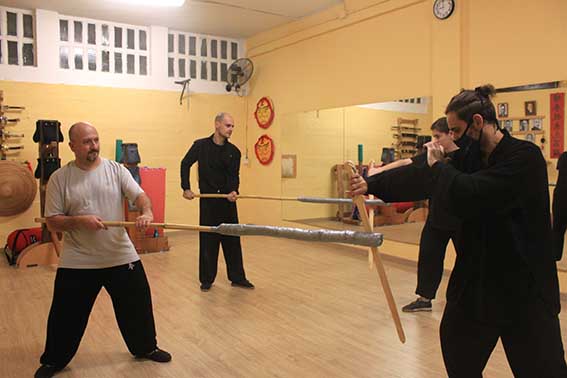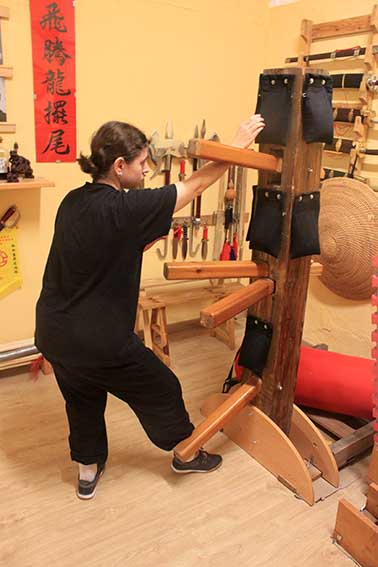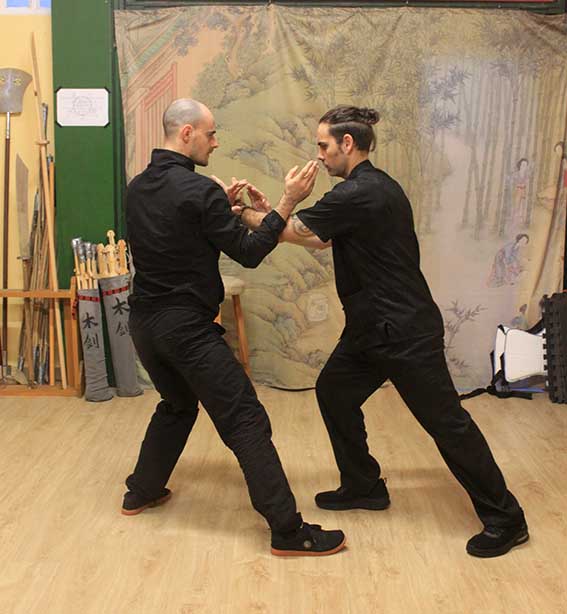Introduction
In any martial art it is important to clearly distinguish the training objectives, and therefore resort to the appropriate methods to achieve them.
A very common mistake in Kungfu and other traditional martial arts is to train without a specific goal, that is, you train for the mere fact of passing time or simply unconsciously.
This is not to say that the mere fact of practicing a martial art does not bring pleasure, and that this pleasure cannot be a goal in itself; of course it is. But, in this case, the practitioner must be aware of this and, if he or she has other goals besides his own enjoyment, he must carefully plan the methods to achieve them.
Objectives and methods
The objectives of a martial art are areas in which to acquire knowledge, skill or efficiency, while methods are all kinds of exercises or training systems designed to achieve these objectives.
Unfortunately, many instructors or schools confuse the method with the goal. For example, Kungfu forms usually become an objective in themselves, without considering what they are made for or what they intend to teach us. Another example can be the use of the wooden dummy, which is often used without clearly understanding what its purpose is (beyond the mere hardening of the body) and what are the benefits it brings us when it comes to acquiring martial skills.

The goals of a martial art can vary depending on the interests of each practitioner. But they should always be planned progressively, so that beginners will have to focus first on achieving certain more basic goals, and these will surely change throughout their training, as their learning progresses.
On the other hand, methods must be adapted to the objectives for which they are designed. It is important to note that if a method does not work to achieve a goal, this method must be changed; in addition, methods have to be tailored or adapted to the individual, and a method that works for one particular person may not work for another.
Therefore, an instructor must be open to adjusting his/her methods according to the characteristics of each student, and to use both traditional methods and modern methods or others designed by him or herself.
Goals of the martial arts
Although this list does not pretend to be exhaustive, among the most common objectives of any martial art we can distinguish the following:
- Body conditioning: It includes aspects such as physical strengthening, hardening, flexibility, endurance and, especially in basic stages, coordination, which is a very important aspect that the student will need to develop to progress in any martial art.
- Technical learning: Within this objective we can encompass the learning of the martial techniques of a specific system or style of martial arts. This aspect focuses on acquiring the techniques and movements characteristic of the system, that is, on learning a certain repertoire of movement, attack and defense techniques, which can include punches, palms, elbows, kicks, etc., up to dislocation and takedown techniques or combat techniques with weapons. But most of all, it's about teaching the body to move efficiently.
- Subtle aspects: These include less visible or perceptible aspects, such as breathing, gaze, mental calmness, tactile perception, or peripheral vision, among others.
- Development of specific skills: Acquisition or development of skills such as speed, explosive power, accuracy or aim, etc.
- Acquisition of tactical concepts: Finally, within this field are included aspects that deal with the understanding of how to apply the martial art. These concepts may include understanding distances, attack and defense strategies, guard positions, space positioning, and the like.
Martial arts methods
Methods for acquiring these goals range from repeated practice of an isolated technique to the practice of qìgōng 氣功 and meditation, including solo combinations, partner combinations, one-person forms, two-person forms, training devices such as wooden dummies, sandbags or wall bags, strengthening exercises, stretching, applications, partner drills, Zhàn Zhuāng 站桩, isolated stance training, footwork, etc.

Zhàn Zhuāng 站桩 practice.
It is impossible to dwell here on all these training methods. Our interest is simply to provoke the reader's reflection on the objectives that each of them intends to achieve.
By way of example, the following may be used:
Choy Li Fut's wooden dummy (Cantonese: ching zong 稱樁) is a very useful traditional training device. However, many practitioners understand this device as a mere system of hardening the body. At a very basic stage, this is true. But the wooden dummy is even more important to develop good footwork, and to teach the practitioner how to move and position himself in relation to his opponent, when to stay in contact and when to detach, etc.
Of course, to achieve these goals, the wooden dummy is not essential; other methods may apply. But when we stand in front of the wooden dummy, we must keep in mind what objectives we want to achieve, to focus on applying the appropriate exercises for that purpose.
If one has not understood the principles that this device intends to teach, and does not know how to apply them to a real situation, training with the wooden dummy will be nothing more than a mere flourish or the recreation of a cultural trait.

Wooden dummy (ching zong 稱樁) training.
As a second example, let's take Tàijíquán 太極拳 pushing-hands (tuīshǒu 推手). Pushing hands is an exercise performed in pairs in which both practitioners alternately exert pressure on their opponent's arm, while the opponent "receives" the push by yielding and redirecting the pushing force.
It must be understood that pushing-hands is not a form of fighting, that is, it does not simulate a real situation; no one fights just pushing, no matter the fact that pushing-hands competitions have been established.
Pushing-hands is a game, a drill by which to develop a fine perception, an understanding of the forces encountered, in order to be able to apply Tàijíquán concepts, namely: not to fight force with force, not to exert direct opposition, but to yield to the force of the opponent by modifying its direction, and to place the opponent in imbalance before responding.
If we work on this drill conscientiously, and the skills for which the exercise has been designed are developed, these skills are extremely useful in a real encounter, especially when we enter the field of grips and dislocations, since the practitioner will be able to respond intuitively and effortlessly to the force of his opponent.

Tàijíquán 太極拳 pushing-hands (tuīshǒu 推手).
Conclusion
In short, the methods of martial art (exercises, forms, etc.) were designed to meet one or more specific objectives. When training, we must be clear about what objectives we intend to achieve, in order to design an appropriate training, applying the correct methods in each case.
Again, our goal may just be to enjoy and have a good time, and that's one hundred percent valid; in this case, we can train according to our desires of the moment without worrying about applying any specific method.
But if we are really involved in the learning and development of our martial art, it is interesting to consider what are the objectives that are intended to be achieved at the level at which we are, to be clear about what each method is designed for, and thus be able to apply it consciously, so that the training time really produces its fruits.
